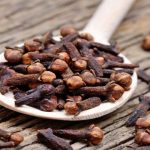 The dried, unopened flower of an East Indian tree used as a spice. Cloves have a rich aroma and hot aromatic flavor. Unopened, aromatic flower bud of a woody, evergreen tree.
The dried, unopened flower of an East Indian tree used as a spice. Cloves have a rich aroma and hot aromatic flavor. Unopened, aromatic flower bud of a woody, evergreen tree.
Although they are both names of items used to season food, the clove that refers to a segment of a garlic bulb is not related to the dove that refers to the aromatic dried spice. First recorded in the leventh century, the garlic dove derives ultimately from an Indo-European word pronounced something like gleubh that meant to cut or to carve; through Germanic, this word developed into dove and was applied to the segments that make up a garlic bulb because those segments appear to have been cut or divided from one another. Close relatives of this dove include tdeft (as in deft chin), cloven (as in cloven hoof), and cleavage (as in what is revealed by a low-cut blouse or droopy pants); all these words describe body parts that appear to have been “cut” or split. A more distant relative of these words, but one that developed from the same Indo-European source, is the glyphics part of the word hieroglyphics, a word of Greek origin that literally means sacred carvings. The other clove—the aromatic spice—derives from a very different source. Its immediate predecessor was the French name of the spice, clou de girofle, which literally means nail of the nut-leaf tree, so named because the tree-bud from which the spice is derived resembles a nail or, in French, a clou. In the thirteenth century, English adopted this French name as clowe gilofre, but eventually this awkward-sounding phrase cleaved into two distinct names: clowe, which became clove, the present name of the spice; and gillyflower, which was originally an alternate name for the spice, but eventually came to refer to a variety of flower whose fragrance resembles that of clove.
A singular component or division that is distinct from other parts within a bulbous structure, for instance, garlic or shallot.
Cloves are the dried, unopened flower buds of an evergreen shrub that thrives in hot, humid climates such as the Moluccas and other similar regions. When freshly harvested, the flower buds exhibit a reddish hue, but they gradually darken to a deep brown, nearly black, as they are dried. Cloves are composed of 16 to 20 percent volatile oil, which possess medicinal properties and provides a distinctively hot, spicy, and aromatic taste and aroma. Whole cloves are utilized in culinary applications for flavoring, and pair exceptionally well with apples. Ground cloves, on the other hand, are used in some cakes and cookies. To extract the flavor of cloves, infusion is sometimes employed for certain purposes.
